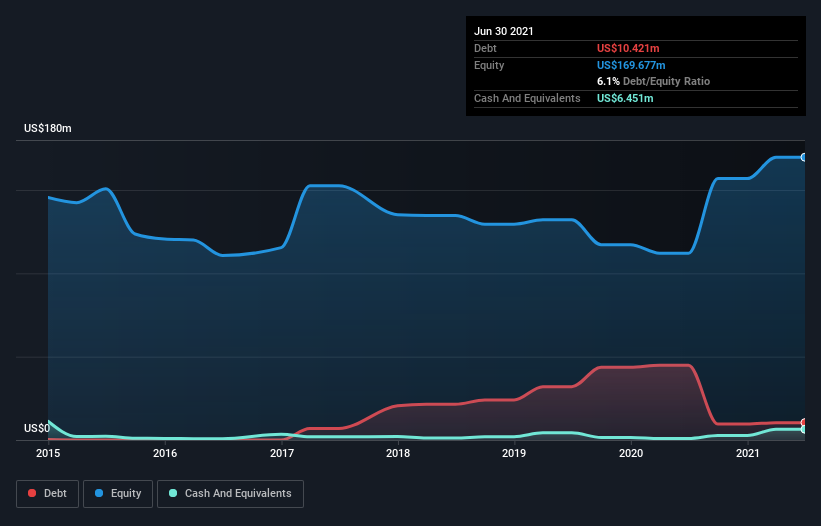Woodbois (LON:WBI) Is Carrying A Fair Bit Of Debt
Howard Marks put it nicely when he said that, rather than worrying about share price volatility, 'The possibility of permanent loss is the risk I worry about... and every practical investor I know worries about.' When we think about how risky a company is, we always like to look at its use of debt, since debt overload can lead to ruin. We can see that Woodbois Limited (LON:WBI) does use debt in its business. But is this debt a concern to shareholders?
What Risk Does Debt Bring?
Generally speaking, debt only becomes a real problem when a company can't easily pay it off, either by raising capital or with its own cash flow. Part and parcel of capitalism is the process of 'creative destruction' where failed businesses are mercilessly liquidated by their bankers. While that is not too common, we often do see indebted companies permanently diluting shareholders because lenders force them to raise capital at a distressed price. Of course, debt can be an important tool in businesses, particularly capital heavy businesses. The first thing to do when considering how much debt a business uses is to look at its cash and debt together.
See our latest analysis for Woodbois
What Is Woodbois's Debt?
The image below, which you can click on for greater detail, shows that Woodbois had debt of US$10.4m at the end of June 2021, a reduction from US$44.9m over a year. However, it also had US$6.45m in cash, and so its net debt is US$3.97m.

A Look At Woodbois' Liabilities
Zooming in on the latest balance sheet data, we can see that Woodbois had liabilities of US$8.71m due within 12 months and liabilities of US$72.4m due beyond that. Offsetting these obligations, it had cash of US$6.45m as well as receivables valued at US$2.49m due within 12 months. So it has liabilities totalling US$72.2m more than its cash and near-term receivables, combined.
This deficit is considerable relative to its market capitalization of US$111.0m, so it does suggest shareholders should keep an eye on Woodbois' use of debt. Should its lenders demand that it shore up the balance sheet, shareholders would likely face severe dilution. There's no doubt that we learn most about debt from the balance sheet. But it is future earnings, more than anything, that will determine Woodbois's ability to maintain a healthy balance sheet going forward. So if you're focused on the future you can check out this free report showing analyst profit forecasts.
In the last year Woodbois had a loss before interest and tax, and actually shrunk its revenue by 20%, to US$15m. To be frank that doesn't bode well.
Caveat Emptor
Not only did Woodbois's revenue slip over the last twelve months, but it also produced negative earnings before interest and tax (EBIT). Indeed, it lost US$3.3m at the EBIT level. When we look at that and recall the liabilities on its balance sheet, relative to cash, it seems unwise to us for the company to have any debt. So we think its balance sheet is a little strained, though not beyond repair. Another cause for caution is that is bled US$10m in negative free cash flow over the last twelve months. So suffice it to say we consider the stock very risky. When analysing debt levels, the balance sheet is the obvious place to start. But ultimately, every company can contain risks that exist outside of the balance sheet. We've identified 3 warning signs with Woodbois (at least 2 which are a bit unpleasant) , and understanding them should be part of your investment process.
When all is said and done, sometimes its easier to focus on companies that don't even need debt. Readers can access a list of growth stocks with zero net debt 100% free, right now.
Valuation is complex, but we're here to simplify it.
Discover if Woodbois might be undervalued or overvalued with our detailed analysis, featuring fair value estimates, potential risks, dividends, insider trades, and its financial condition.
Access Free AnalysisHave feedback on this article? Concerned about the content? Get in touch with us directly. Alternatively, email editorial-team (at) simplywallst.com.
This article by Simply Wall St is general in nature. We provide commentary based on historical data and analyst forecasts only using an unbiased methodology and our articles are not intended to be financial advice. It does not constitute a recommendation to buy or sell any stock, and does not take account of your objectives, or your financial situation. We aim to bring you long-term focused analysis driven by fundamental data. Note that our analysis may not factor in the latest price-sensitive company announcements or qualitative material. Simply Wall St has no position in any stocks mentioned.
About AIM:WBI
Woodbois
Engages in the forestry, timber trading, and carbon solutions in Guernsey, Denmark, Mozambique, and the United Kingdom.
Moderate risk with mediocre balance sheet.
Market Insights
Community Narratives




